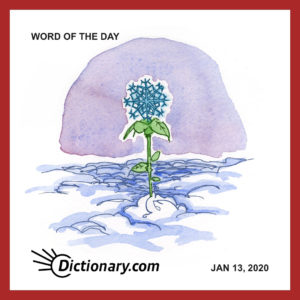Word of the Day
More about trangam
Trangam, also spelled trangame, trangram, and trankum, is a rare noun with no obvious etymology. Sir Walter Scott (1771–1832) helped revive trangam in The Abbot (1820), one of the earlier Waverley Novels. Trangam entered English in the 17th century.
how is trangam used?
And meet time it was, when yon usher, vinegar-faced rogue that he is, began to enquire what popish trangam you were wearing …
Go, go your ways, get you gone, and finefy your Knacks and Tranghams …
mythomane
noun
a person with a strong or irresistible propensity for fantasizing, lying, or exaggerating.
More about mythomane
The noun and adjective mythomane is a relatively recent word, dating from only the 1950s, and is a synonym for the noun and adjective mythomaniac, which is almost a century older (1857). Mythomaniac originally meant someone passionate about or obsessed with myths, its etymological meaning. By the early 1920s mythomaniac had acquired its current sense “someone with a strong or irresistible propensity for fantasizing, lying, or exaggerating.” The Greek noun mŷthos means “word, discourse, conversation, story, tale, saga, myth”; it does not mean “lie.” The curious thing is that the source word mythomania “lying or exaggerating to an abnormal degree” dates from only 1909.
how is mythomane used?
Lawrence himself was a mythomane and, after the first world war, took particular pains to project an image of himself to the public that was as much a construct as anything worked up by the PR team of a film star or celebrity of today.
… he is a flat-out mythomane, dedicated to the Sublime, the Enormous and the Ultra-German; a marvelous artist at his best and at his worst a Black Forest ham.
More about nival
The adjective nival comes straight from Latin nivālis “of or belonging to snow, snowy, covered in snow,” a derivative of the noun nix (inflectional stem niv-) “snow.” The adjective is relatively rare, being confined to zoology, botany, and physical geography. Nix is related to English snow, Sanskrit sneha-, Slavic (Polish) śnieg, and Irish snigid “it’s raining.” Nival entered English in the mid-17th century.

how is nival used?
… when the Alpine climbers ascend the snow-clad mountains of picturesque Switzerland and gather a pretty little bouquet of a dozen different nival flowers, on that barren zone ….
The nival region is characterised by accumulating snow deposits, both in the completely nival province where precipitation takes the form solely of snow and the semi-nival province where this is interrupted by rainfall.